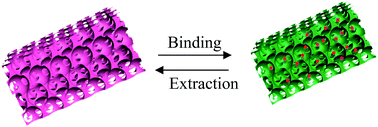Inverse opals of photonic crystal hydrogels for selective sensing of lead ions†
Abstract
Acrylamide (AM) and hydroxyethyl methacrylate (HEMA) copolymer based inverse opals of photonic crystal hydrogels (PCHs) were fabricated by using the colloidal crystal template method. The effects of pH, ionic strength and compositions on the response properties of PCHs were investigated. The resultant PCHs with a highly ordered three-dimensional interconnected macroporous structure exhibited high sensitivity and selectivity to lead ions (Pb2+). With the increment of concentration of Pb2+ from 0 mol L−1 to 10−2 mol L−1, the Bragg diffraction peak of PCHs blueshifted 78 nm and the color changes could be visible to the naked eye. Simultaneously, PCHs delivered a negligible Bragg diffraction peak shift in other metal ion solutions (Cu2+, Cd2+, Zn2+ and Ni2+), demonstrating the high specificity of PCHs to Pb2+. Furthermore, the PCHs exhibited efficient recognition properties to Pb2+ in the multicomponent metal ion solution. Specific recognition, rapid response and signal self-reporting of PCHs to Pb2+ provide great potential for the real-time monitoring of Pb2+.



 Please wait while we load your content...
Please wait while we load your content...